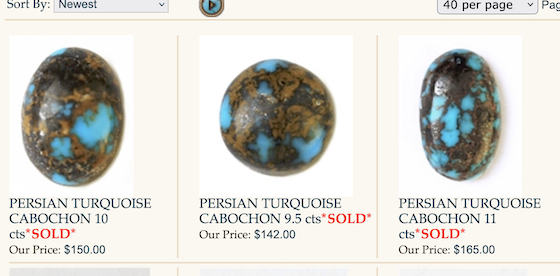So what are. you thoughts on my new cuff. It is sterling and large. I love the Blue stone, Black matrix, green deposits along with quartz. Possibly Kingman spiderweb? @Jason Thank you all, Simone
Possibly Smokey Kingman? @Jason
Thank you Simone
So what are. you thoughts on my new cuff. It is sterling and large. I love the Blue stone, Black matrix, green deposits along with quartz. Possibly Kingman spiderweb? @Jason Thank you all, Simone
@Simone Agree, not spiderweb.
Thank you, I really thought it matched just thought it matched these pics which is Kingman spider web. also with the quartz black matrix , green deposits ![]()
I think you’re looking at color similarity, but pattern is what makes spiderweb what it is. It means a weblike look to the stone, as if there are little cells of the turquoise and the matrix cheek to jowl alternating, and very tightly compacted together. This is different from a stone with smooth overall areas of just the turquoise or just the matrix. In short, the web analogy is helpful.
Thank you for your knowledge. ![]()
I found this link interesting: Grading Turquoise Matrix: What Turquoise Patterns are Made of – Turquoise Skies (tskies.com)
The spiderweb pattern has been generally accepted by most in the turquoise industry as the most valuable pattern. It is rare to find in nature and is said to have the best structure. This is why the exaggerated versions of this pattern score this highest possible score of a +5 of the matrix pattern scale. This is important to know because these patterns are prone to be replicated by engineered imitations.

The Calico pattern consists of layers of three or more colors from three different elements. The pattern is formed from a set of natural turquoise blue, a black or brown mother stone matrix and a metallic element such as pyrite. The pattern gets its name from the fur patterns on a calico cat. It is not usually as valuable as the spiderweb pattern though it is rare to find large enough quantities of pyrite and quality turquoise on one stone. The most concentrated forms of this get a +4 on the pattern scale.

For me looking at cut and polished stones is easier than looking at rough. But it’s still a guessing game for most of us.
Persian famously has a rich rusty, chocolatey brown matrix. (I think Kingman’s most likely for this cuff.)

when in doubt, it’s probably Kingman. like, 99% of the time… it’s Kingman.
image source: 3100 listings from 1 seller on ebay
all color variations of Persian turquoise
3,099 other variations of Persian turquoise listed by this seller ← CLICK
Wow, you think so, this will be my first of Persian?
Very interesting, it’s a beautiful piece would you consider this high grade?
wow, this is very interesting, Thank you!
We need Jason to weigh in. Remember we are all just speculating.
I cannot speak to the grade, but when I looked at @chicfarmer’s link, the high grade Persian looked quite different from these. If it’s Persian.
I don’t think Persian when I look at your cuff. All of the Persian I have has a brownish matrix, not the deep black. I also don’t remember seeing Persian with the white spots. I’m leaning more towards Kingman. There is also a newer mine that has a matrix of black splotches but it’s not one I’m familiar with and I can remember the name at the moment. Pretty cuff ![]()
I posted this photo a couple of years ago, but here it is again to add to the conversation on Persian turquoise.
Photo and caption from the book, Turquoise Treasures , 1975.
I think that one of the things that can also help identify Persian turquoise is the cut. Look at all the images that have been provided of Persian turquoise and you will notice a symmetrical cut. All of the Persian turquoise we have in the store is symmetrical. I imagine after the turquoise had been mined it was shipped to a cutter somewhere out of Iran. The three stones in this cuff are all freeform cuts and I imagine if you took one out it would have backing (something you also don’t see in Persian stones).